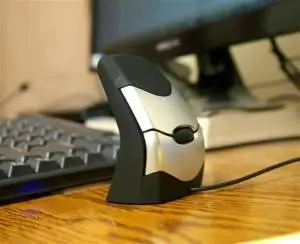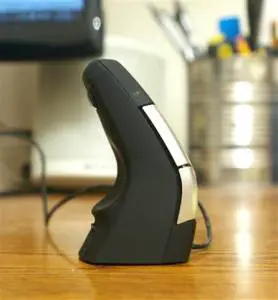A couple of years ago, I wrote that the Evoluent vertical mouse “is probably what the standard ‘mouse’ should look like.” I have now found another model that I think is even closer to this ideal: The DXT precision mouse from City Ergonomics. Here’s why.
A bit of background
A few weeks ago, I had the privilege of conducting a Skype interview with James Bowden, inventor of the DXT mouse. We used Skype because Mr. Bowden is based in the UK, where he and his son Stephen manufacture and market the DXT through their company, City Ergonomics. The Bowdens are truly interesting folks whom I would love to meet in person someday. (They also have the most delightful accents; I could listen to them read the phone book.)

The DXT mouse looks simple, but its design addresses serious ergonomic issues in a truly elegant way.
Mr. Bowden is well qualified to address physiological ergonomic issues, having spent his career as a physiotherapist. While working in that capacity at Shell Oil, he noticed that one department – exploration and development – was sending him more than its share of back and neck patients. Upon investigation, he discovered that this line of work requires near-constant mouse use. The department provided a type of ergonomic mouse, which did help to prevent wrist problems, but didn’t seem to do much for the neck and shoulder epidemic.
After years of dealing with the situation, Mr. Bowden concluded that the world needed a new mouse design. In 2005, he and the younger Mr. Bowden – a career ergonomist – created the DXT precision mouse based on their experience and expertise.
So it’s another vertical mouse. So what?
The DXT mouse is not the first vertical design to hit the market. That sector is already crowded with such luminaries as the aforementioned Evoluent, the 3M ergonomic mouse, and the AirO2bic – just to name a few I’ve personally tried. All make the same basic claim: Palm-flat mousing is unnatural and evil, “handshake” mousing is natural and good. They then sprinkle this concept with their own particular flavor, for example, “zero pinch-force,” “wireless freedom,” or even “lighted logo.” (Sorry, Evoluent.) The DXT has a flavor too – but in my opinion, it offers a bit more substance than some of the others. Let’s look at a few key points.
Precision, precision, precision
The majority of ergonomic mouse designs sacrifice some degree of precision by transferring the workload from your hands and fingers to your arms, shoulders, and elbows. Intuitively, the reasoning behind this is quite sound. The muscles and tendons in your arms are bigger, therefore stronger and harder to damage, than the small ones that control your fingers. Also, mousing with the entire arm tends to keep your wrist straight, without the harmful sideways wrist-flicks of the conventional mouse.
As a user of the Contour mouse – one of the original “whole arm” designs – I’ve dealt with this issue of precision for many years, and worked around it in two ways. When doing moderately precise work, I shift to Contour’s “precision” posture, an alternative position where the heel of the hand rests on the work surface. For the really precise tasks, I keep a Wacom tablet and stylus handy.
The DXT mouse reverses the common arm-loading approach. Instead, it unloads your arm and shoulder, and transfers nearly all the work to your hand and fingers. Using the DXT, in fact, feels very much like using the stylus I mentioned earlier, and the resulting precision is about what you would expect. It is also easy and natural to use without retraining – so much so that I quickly turned the onboard DPI setting all the way up, and kept perfect control. I even found that my left hand could work with almost as much finesse as my right (and I am very right-handed).
What of the concern about small tendons? Mr. Bowden holds that the hand and fingers are perfectly capable of pulling their own weight – if they are kept within safe ranges of motion, without being locked into one repeated position. This concept drives everything about the DXT mouse design. Being physically small, vertically oriented, and capable of very high operating speeds, it allows the hand to accomplish a lot of work with a little motion – all while keeping the wrist in a neutral position.
Made for use, not rest
Try this experiment sometime: Don’t use your left arm for two weeks. At the end of that period, see which of your arms is in better shape. On second thought, don’t try that; you already know the result anyway. Our bodies were designed for motion – that’s how they develop and maintain strength. Yet many ergonomic devices address pain issues by permanently immobilizing the “trouble spot,” such as the wrist or fingers. This approach generally stops the pain, but risks atrophying the immobilized joints. Also, the same stress may simply be transferred to another area, which will become its own “trouble spot” with time.
Far better, counsels Mr. Bowden, to fix the problem at the root. Every part of the body was made to be used, so don’t immobilize it – design devices that use it properly, within its natural range of motion. This reasoning feels right to me, and the DXT mouse in my hand feels even righter.
Natively ambidextrous
 Since the mousing hand tends to get overworked, many people like to split the load. Most ergonomic mice come with hand-specific versions, so the ambidextrous user ends up investing in not one, but two expensive new gadgets. Not so with the DXT, which is elegantly ambidextrous by design.
Since the mousing hand tends to get overworked, many people like to split the load. Most ergonomic mice come with hand-specific versions, so the ambidextrous user ends up investing in not one, but two expensive new gadgets. Not so with the DXT, which is elegantly ambidextrous by design.
Since the DXT mouse is vertical, right-click and left click don’t change positions when you change hands. Because its cable comes out the side and not the back, it doesn’t change positions either. The pointer and scroll wheel do unavoidably reverse course, but these can be changed with the touch of a handy button, and the current mode tracked with two easy-to-see blue lights.
Do you believe in the Pinch Force Monster?
In any discussion of vertical mice, someone will soon mention “pinch force,” with an ominous shudder. The warning goes like this: Most vertical mice require you to “pinch” the mouse between your thumb and forefinger in order to click. (The AirO2bic mouse is an exception; it is held steady by the weight of your hand, so there is no need to pinch.) This pinch force, you are solemnly assured, will eventually blow out some part of your hand – probably your thumb. Best stay away from vertical mice.
 When I brought up the pinch force concern to Mr. Bowden, he responded with some interesting facts and a bit of history. Pinch force, he says, first came on the ergonomic radar from the medical industry, where it dogged endoscope operators. Endoscopists basically spend their lives squeezing a handle, and this repeated squeezing action was found to cause certain types of RSI. When you apply this logic to the vertical mouse, it suddenly doesn’t look so ergonomic anymore. But wait – does this logic apply to a typical vertical mouse? Mr. Bowden says no.
When I brought up the pinch force concern to Mr. Bowden, he responded with some interesting facts and a bit of history. Pinch force, he says, first came on the ergonomic radar from the medical industry, where it dogged endoscope operators. Endoscopists basically spend their lives squeezing a handle, and this repeated squeezing action was found to cause certain types of RSI. When you apply this logic to the vertical mouse, it suddenly doesn’t look so ergonomic anymore. But wait – does this logic apply to a typical vertical mouse? Mr. Bowden says no.
Here’s the key: Studies found that repeated pinch force is only a concern if that force is more than about 2.2 pounds. Here’s another experiment for you: Get a kitchen scale and press down on it with your fingers until the meter shows two pounds. Now ask yourself how that compares to the force you use when clicking a mouse. Unless you’re one of these folks who feels compelled to press on peripherals until the plastic deforms, I’m guessing you stay well below the threshold of danger.
So in short, according to Mr. Bowden, there is a Pinch Force Monster – but unless you’re an endoscopist (or someone who cuts thick things with scissors for a living) you don’t have to worry about him.
Footprints on the desk
The DXT has one of the smallest footprints I’ve ever seen, which makes it great for compact installations. I found it nested nicely to the right of my split Kinesis Freestyle keyboard, and worked well on the smooth surface of my desk.
Though small, the mouse is also tall – tall enough to trip my hand up once or twice on the way over to the keyboard. Problems like this one tend to go away as you get used to them, so I wouldn’t worry about any long-term trip hazard.
One thing I would worry about is the height of your desk. To use the DXT – or any vertical mouse – it must be at or a little below the level of your elbow. This point cannot be overemphasized: If you try to use a vertical mouse on a desk that’s too tall, you’ll get zero ergonomics, plenty of ouches, and probably some copious medical bills. Please don’t go there!
Conclusion
The DXT mouse has a whole lot of things going for it. It presents the “handshake” grip in a compact, ambidextrous package that yields comfort and remarkable precision with zero retraining. Unless you have a high work surface that you can’t change, there’s no ergonomic mouse I would recommend more highly.
Disclosure: This review was made with a complimentary sample from City Ergonomics’ US distributor.
Our company, Cyberwitz LLC, provides various services for City Ergonomics, unrelated to my evaluation of their products. Opinions expressed here, naturally, are my own.
- Your Complete Guide To The Best Ergonomic Kneeling Chairs - March 25, 2024
- 5 Best Ergonomic Wine Bottle Openers - March 4, 2024
- Handshoe Mouse Review - January 23, 2024





